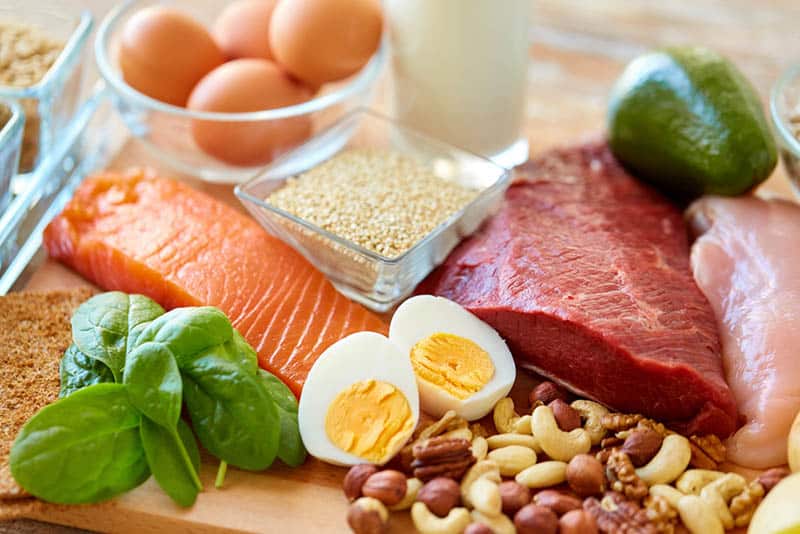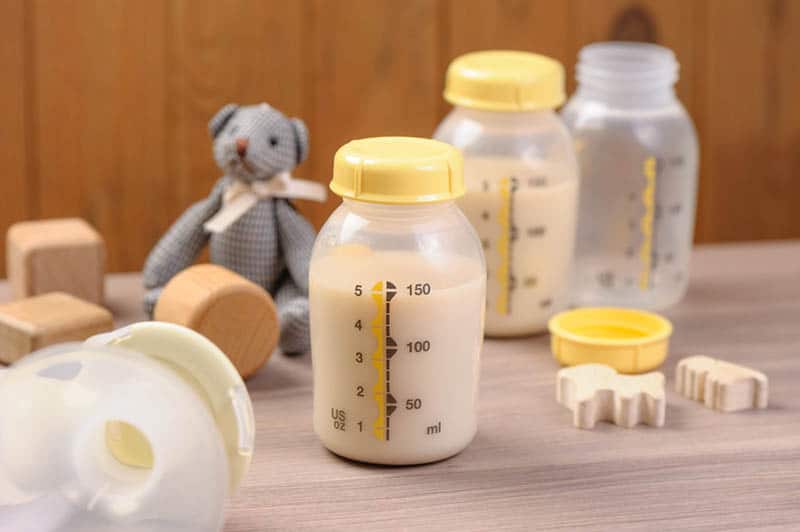If you’ve been wondering how to make breastmilk fattier, you’re not alone.
Many breastfeeding moms worry their babies might not be getting enough nutrients and want to know how they can make sure they are.
To figure out how to make breastmilk fattier, you simply need to look at some of the simpler solutions, like consuming more healthy fats, as not all fats are good for our kids.
Another major point to consider is eliminating any potential foremilk or hindmilk imbalance that could disturb the overall fat content of breast milk, and lead to some annoying issues for your little one.
These are all common concerns of every mom, which is why you should be aware of just how important it is to have the proper amount of fat produced by your milk ducts.
Read on to discover how important these healthy fats are and what you can do to produce more of them and help your kiddo grow up big and strong.
How To Make Breastmilk Fattier?
There are plenty of ways to increase breast milk fat content to provide your darling child with all the healthy, fatty milk they need.
You don’t have to try them all at once, but keep your mind open to options you hadn’t considered before, like using a breast pump.
Here are a few of the most common methods:
1. Putting more (healthy) fats in your diet

As mentioned previously, children require lots of fats to fuel them in their early years, which is why it’s so important for them to always get as much as they need regularly.
However, the type of fat they’re getting also matters for your little one’s overall health.
All the trans and saturated fats are abundant in many types of food, but they’re not the healthiest ones overall.
My suggestion is to stick to the healthier, and more natural, unsaturated fats wherever you can.
The most common foods you find them in include olive oil, eggs, avocados, various types of seeds and nuts, and salmon.
While there’s no real way to avoid the unhealthy type of fats, try to minimize your intake of them.
Don’t try to eliminate them altogether, though, especially if some of your favorite foods include them.
2. Make sure to nurse often

An important thing which many new moms don’t realize is that our breast milk is actually a combination of two different types, foremilk and hindmilk.
The foremilk is a type of watered-down appetizer that helps prepare the child for the main course.
It increases his appetite for the hindmilk, which is the part of mother’s milk with the higher fat content.
It’s the hindmilk that satisfies your child’s hunger and is filled with all the healthy fats he needs to grow up to be big and strong.
But improper nursing with an erratic feeding schedule can lead to a foremilk/hindmilk imbalance, as it takes some time for the latter to come out.
If the feed doesn’t last long enough, or the breast isn’t fed on often enough, it doesn’t get a chance to come out.
This can potentially lead to a whole number of other problems.
First off for you in the form of clogged milk ducts, which might obstruct milk flow and lead to breast engorgement and other types of nursing pain.
It also creates a problem for your baby, as his tummy won’t feel like it’s full because the high fat content of hindmilk is responsible for dousing his feeling of hunger.
This, in turn, can lead to excessive weight gain that might cause the baby to become overweight.
3. Get more protein in your diet

While fats are important, they aren’t the only thing you or your child need to stay healthy.
But when it comes to how to make breastmilk fattier, protein does play an important role in your body.
It helps stimulate milk production and maintain a regular milk supply for breastfeeding moms.
This helps bring the balance back between the amount of foremilk and hindmilk.
Some of the best sources of protein are:
• Chicken breast
• Fish
• Dairy products
• Various types of nuts
• Lean meats
• Various types of seeds
• Eggs
I’ve already mentioned some of these, like seeds and nuts, as they also contain healthy fats.
These foods have everything you’ll need to keep both yourself and your child healthy in almost every aspect, especially flaxseed.
If you are vegan or vegetarian, you might also want to try drinking some protein shakes to make sure you’re getting enough protein in your diet.
Regardless of your dietary restrictions, you can find protein powders to suit your needs.
4. Take supplements to increase breast milk supply

Breastfeeding supplements for moms whose milk supply is decreasing, and who are having issues supplying enough milk for every feeding session, are also a great way to make breastmilk fattier.
Some moms simply can’t pump enough milk out at a consistent pace, which is perfectly normal as a lot of outside factors, like stress, can lead to a temporary slowing of milk production.
One of the more popular supplements, which many pediatricians recommend to moms who suffer from clogged milk ducts or general breast pain, is the sunflower lecithin supplement.
It helps bind the foremilk and hindmilk together, allowing it to mix properly and pass through the ducts easier without creating a blockage.
It also helps provide relief to moms for whom the traditional physical methods of breast relaxation through massaging or breast compressions, don’t seem to work.
It’s a great trick that many breastfeeding mothers use so that their baby doesn’t only have to rely on getting the fatty acids from hindmilk at the end of the feeding, and instead get it throughout the feeding session.
This helps minimize the risk of a fussy baby or excess weight gain.
It also helps you drain your breasts a lot more efficiently.
Before taking any sort of supplement, make sure to check whether or not they’re safe for you with your doctor, lactation consultant, or any other qualified healthcare professional.
While most women don’t have any issues taking these, you should pay close attention to dosing instructions as there’s always that risk that you or your child might be allergic to some of the contents, so don’t go rushing off to the drugstore without doing your research.
5. Make sure to fully drain the breast after a feed

An empty breast is a happy breast, and switching breasts is a habit that many new moms need to kick, as it’s a trap.
It does make some sense to keep balance, to be fair, but it can also cause trouble.
The main reason is due to the two types of milk mentioned before.
If the child only sucks from one breast, he’ll get to feed on both the foremilk that comes at the start and the fatty, rich hindmilk that comes at the end of the session.
This is because most of the fatty milk ends up getting stuck in the milk ducts, also known as the alveoli, and it takes time for it to reach your baby.
If you swap breasts in the middle of a feed, he’ll be getting a lot more foremilk, which will lead to the problems we discussed before.
It simply doesn’t end up satisfying all of the baby’s needs and leaves him hungry for more.
If you really need a way to breastfeed that completely empties both breasts, make sure to read the next tip.
6. Start using a breast pump

Emptying one breast at a time is important, but it’s also important to alternate between breasts as they start producing more milk once they fully drain, so they can keep up with the demand.
However, you’re probably nursing only one baby, unless you were lucky enough to have twins (or more!).
So how can you make sure that both breasts get fully drained and produce a similar amount of milk?
One of the best solutions is to get a breast pump.
Either a manual pump or an electric one, it comes down to preference, and what kind (if any) your insurance company offers a discount for.
Just make sure to get a few storage bags or bottles for the milk you’re going to be pumping so you can store it for later use.
You can even freeze the extra milk for a couple of months so you always have a stash!
The alternate method of using a pump, if you’re wondering how to make breastmilk fattier, is to pump a little milk at the start so your child can get to the richer milk quicker.
7. Start doing breast compressions and massages

Sometimes, a little bit of manual stimulation is required to get the milk flow going again and allow the fatty milk to pass through the alveoli.
You can massage your breasts before a feed to stimulate the tissue and ease the symptoms of the engorgement of the breast.
Massage also helps with unclogging the milk ducts and preventing mastitis.
You can compare breast massages to doing maintenance work on a machine, (not very glamorous, I know) which helps the milk to flow smoothly without blockages.
The compressions help stimulate a faster flow of milk when the child is already feeding.
It’s as simple as grabbing your breast and rolling your finger down one side with the rest of the hand cupping the breast.
It helps eject the milk with a bit more pressure and also helps break through some potential blockages when the milk’s already moving.
Try doing this in short intervals so as to not overwhelm your baby with too much milk.
You’ll feel a lot of relief in your breasts, while your baby will get everything he needs for a healthy body and brain development.
8. Try separating the milk

The final thing I recommend is to stop hassling yourself with all of these methods, and instead try separating the two types of milk yourself.
This is a method exclusive to pumping mammas, though.
I know some moms like to practice exclusive breastfeeding, and that’s fine, but if you’re concerned about making your milk fattier, then it’s worth investing in a pump.
Electric breast pumps are obviously pricier than manual ones, but you can find high-quality ones for under $100 on Amazon, and they make pumping a lot easier.
To begin, take your pump and turn it on to start draining the breast.
After about a minute or two, when you see your milk flow become steady, pause the pump and replace the storage container with a fresh one, then continue pumping until you’re done.
When you’re done, compare the two containers.
The difference should be obvious, but for those who are looking at it for the first time, the foremilk will be a lot more liquid and clear.
It might even appear somewhat blueish.
On the other hand, the hindmilk will appear a lot creamier, similar to cow’s milk, and might even be a bit yellow-ish.
Don’t worry, it’s not spoiled, it’s just its natural color.
Congratulations, you’ve managed to successfully separate the fore and hindmilk and can now freely choose which one to give to your child first!
I do still recommend a mix of the two as both contain vital nutrients and vitamins for your little one’s healthy physical and mental development.
After all, this is what nature intended for every baby.
Why Is Having Enough Fat In Breastmilk Important?

The reason so many mothers wonder how to make breastmilk fattier (especially those whose babies are skinny) is because fats are a vital component of our everyday diets, and doubly so for children.
It’s our body’s way of storing excess energy. Think of bears who fatten up for the winter so they can hibernate, burning that excess energy throughout.
For children, however, fat fuels the most adventurous and crucial period of their lives, infancy.
It’s the secret ingredient that allows them to remain so cheery and excited even after hours of running around.
But, that’s not all, as it’s also a key component in the development of many aspects of the human body.
The healthy fats help develop the nervous system, improve eyesight, and even aid in overall brain development.
Fat is also a key component in keeping our skin’s elasticity and smoothness, as well as acting as food for our cells and a method of producing certain types of vitamins that are necessary for the body to thrive.
However, it’s important to keep a healthy balance of fats in your body, as too much can incur a risk of obesity and different types of heart disease and other problems, even in children.
All of this is why it’s so important for our kids to get their daily recommended amounts of healthy fats.
Most of them come from breast milk, but sometimes they might need supplementing if there’s an issue with the milk supply.
There are different types of fats, with the healthy ones being the unsaturated fats, as we mentioned before.
They can be separated into two different categories, the monounsaturated and polyunsaturated fats, which are found in avocados, fish, various types of nuts and seeds, olive, sesame, and sunflower oils, as well as canola oil.
The polyunsaturated fats are better known as Omega-3 oils.
Then you have the unhealthy fats, which are the trans and saturated fats.
These are most often found in processed foods and many different dairy products and red meats.
You can find unhealthy fats in fast food and “junk” foods, which already tells you that they’re quite bad for you.
The key is to consume as much of the healthy type of fat as you can, while minimizing the intake of unhealthy fat.
This shouldn’t be a big problem for babies unless they have infantile lactose intolerance which causes them to switch to formula.
This sometimes requires them to take fat supplements, and it’s important to choose the right ones.
I suggest you seek further advice on this matter from your lactation consultant or your child’s pediatrician, as they can give you a proper answer and tailor a diet suitable to your child’s specific needs.
In Conclusion

Trying to figure out how to make breastmilk fattier isn’t always an easy task.
Sometimes, there are factors that us moms can’t control that affect our supply of milk.
This makes it hard for us to give our little babies the fats they need for their bodies to develop in a healthy manner.
The best thing we can do is to maintain a healthy diet ourselves so our breast milk remains rich in healthy fats, and to make sure our milk production doesn’t drop due to external factors.
Should an issue ever pop up, I suggest turning to your lactation consultant, your family doctor, or your child’s pediatrician as soon as you can to help resolve it quickly.
Friends and family can offer well-meaning advice, but that won’t always be applicable to your situation.
Besides, there might be some underlying health problems you’re not aware of that are preventing a smooth breastfeeding journey.
That’s where your doctor comes in.
Make sure to prepare all your questions beforehand – it pays off to be diligent about your health.
Until next time, mammas!
Like this post? Please share or pin it for later. You can also stay in the loop and follow us on Facebook, Instagram or Pinterest.

We love honesty! Find Your Mom Tribe is an Amazon Associate and we earn from qualifying purchases through affiliate links at no extra cost to you. Please see our full Amazon Affiliate disclosure for more information.

